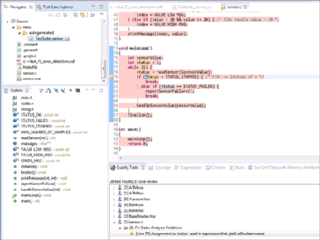Related Research Articles
Software testing is the act of examining the artifacts and the behavior of the software under test by validation and verification. Software testing can also provide an objective, independent view of the software to allow the business to appreciate and understand the risks of software implementation. Test techniques include, but not necessarily limited to:
In software quality assurance, performance testing is in general a testing practice performed to determine how a system performs in terms of responsiveness and stability under a particular workload. It can also serve to investigate, measure, validate or verify other quality attributes of the system, such as scalability, reliability and resource usage.
A software company is a company whose primary products are various forms of software, software technology, distribution, and software product development. They make up the software industry.
In software engineering, a test case is a specification of the inputs, execution conditions, testing procedure, and expected results that define a single test to be executed to achieve a particular software testing objective, such as to exercise a particular program path or to verify compliance with a specific requirement. Test cases underlie testing that is methodical rather than haphazard. A battery of test cases can be built to produce the desired coverage of the software being tested. Formally defined test cases allow the same tests to be run repeatedly against successive versions of the software, allowing for effective and consistent regression testing.
A test script in software testing is a set of instructions that will be performed on the system under test to test that the system functions as expected.
Exploratory testing is an approach to software testing that is concisely described as simultaneous learning, test design and test execution. Cem Kaner, who coined the term in 1984, defines exploratory testing as "a style of software testing that emphasizes the personal freedom and responsibility of the individual tester to continually optimize the quality of his/her work by treating test-related learning, test design, test execution, and test result interpretation as mutually supportive activities that run in parallel throughout the project."
Game testing, a subset of game development, is a software testing process for quality control of video games. The primary function of game testing is the discovery and documentation of software defects. Interactive entertainment software testing is a highly technical field requiring computing expertise, analytic competence, critical evaluation skills, and endurance. In recent years the field of game testing has come under fire for being extremely strenuous and unrewarding, both financially and emotionally.
Software quality management (SQM) is a management process that aims to develop and manage the quality of software in such a way so as to best ensure that the product meets the quality standards expected by the customer while also meeting any necessary regulatory and developer requirements, if any. Software quality managers require software to be tested before it is released to the market, and they do this using a cyclical process-based quality assessment in order to reveal and fix bugs before release. Their job is not only to ensure their software is in good shape for the consumer but also to encourage a culture of quality throughout the enterprise.
Manual testing is the process of manually testing software for defects. It requires a tester to play the role of an end user where by they use most of the application's features to ensure correct behaviour. To guarantee completeness of testing, the tester often follows a written test plan that leads them through a set of important test cases.
Agile testing is a software testing practice that follows the principles of agile software development. Agile testing involves all members of a cross-functional agile team, with special expertise contributed by testers, to ensure delivering the business value desired by the customer at frequent intervals, working at a sustainable pace. Specification by example is used to capture examples of desired and undesired behavior and guide coding.

In software development, the V-model represents a development process that may be considered an extension of the waterfall model, and is an example of the more general V-model. Instead of moving down in a linear way, the process steps are bent upwards after the coding phase, to form the typical V shape. The V-Model demonstrates the relationships between each phase of the development life cycle and its associated phase of testing. The horizontal and vertical axes represent time or project completeness (left-to-right) and level of abstraction, respectively.
There is considerable variety among software testing writers and consultants about what constitutes responsible software testing. Proponents of a context-driven approach consider much of the writing about software testing to be doctrine, while others believe this contradicts the IEEE 829 documentation standard.
A test strategy is an outline that describes the testing approach of the software development cycle. The purpose of a test strategy is to provide a rational deduction from organizational, high-level objectives to actual test activities to meet those objectives from a quality assurance perspective. The creation and documentation of a test strategy should be done in a systematic way to ensure that all objectives are fully covered and understood by all stakeholders. It should also frequently be reviewed, challenged and updated as the organization and the product evolve over time. Furthermore, a test strategy should also aim to align different stakeholders of quality assurance in terms of terminology, test and integration levels, roles and responsibilities, traceability, planning of resources, etc.
Augmented reality-based testing (ARBT) is a test method that combines augmented reality and software testing to enhance testing by inserting an additional dimension into the testers field of view. For example, a tester wearing a head-mounted display (HMD) or Augmented reality contact lenses that places images of both the physical world and registered virtual graphical objects over the user's view of the world can detect virtual labels on areas of a system to clarify test operating instructions for a tester who is performing tests on a complex system.
James Marcus Bach is an American software tester, author, trainer, and consultant.

Parasoft C/C++test is an integrated set of tools for testing C and C++ source code that software developers use to analyze, test, find defects, and measure the quality and security of their applications. It supports software development practices that are part of development testing, including static code analysis, dynamic code analysis, unit test case generation and execution, code coverage analysis, regression testing, runtime error detection, requirements traceability, and code review. It's a commercial tool that supports operation on Linux, Windows, and Solaris platforms as well as support for on-target embedded testing and cross compilers.
Acceptance test–driven development (ATDD) is a development methodology based on communication between the business customers, the developers, and the testers. ATDD encompasses many of the same practices as specification by example (SBE), behavior-driven development (BDD), example-driven development (EDD), and support-driven development also called story test–driven development (SDD). All these processes aid developers and testers in understanding the customer's needs prior to implementation and allow customers to be able to converse in their own domain language.
Test environment management (TEM) is a function in a software delivery process which aids the software testing cycle by providing a validated, stable and usable test environment to execute the test scenarios or replicate bugs.

Crowdsourced Testing is a crowdsourcing platform which provides functional, localization, usability and Beta testing through crowdsourcing.
This article discusses a set of tactics useful in software testing. It is intended as a comprehensive list of tactical approaches to Software Quality Assurance (more widely colloquially known as Quality Assurance and general application of the test method.
References
- 1 2 Bach, Jonathan (November 2000). "Session-Based Test Management" (PDF).